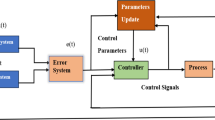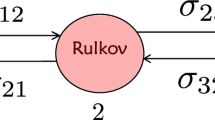Abstract
This paper is concerned with a class of high-order cellular neural networks (HCNNs) model with time-varying delays in the leakage terms. By using the Lyapunov functional method and differential inequality techniques, we establish sufficient conditions on the existence and exponential stability of anti-periodic solutions for the model. Our results complement some recent ones.
MSC:34C25, 34D40.
Similar content being viewed by others
1 Introduction
In the past decade, high-order cellular neural networks (HCNNs) have attracted much attention due to their wide range of applications in many fields such as signal and image processing, pattern recognition, optimization, and many other subjects. There have been extensive results on the problem of global stability of periodic solutions and anti-periodic solutions of HCNNs in the literature (see [1–5]). Recently, some attention has been paid to neural networks with time delay in the leakage (or ‘forgetting’) term (see [6–15]). In particular, Xu [16] considered the existence and exponential stability of the anti-periodic solutions for the following HCNNs with time-varying delays in the leakage terms:
in which n corresponds to the number of units in a neural network, corresponds to the state vector of the i th unit at the time t, represents the rate with which the i th unit will reset its potential to the resting state in isolation when disconnected from the network and external inputs, , and are the first- and second-order connection weights of the neural network, corresponds to the time-varying leakage delays, , and correspond to the transmission delays, and correspond to the transmission delay kernels, denotes the external inputs at time t, , and are the activation functions of signal transmission.
The initial conditions associated with system (1.1) are of the form
where denotes a real-valued bounded continuous function defined on .
Under some suitable conditions on coefficients of (1.1), the author in [16] derived some new sufficient conditions ensuring that all solutions of system (1.1) converge exponentially to the anti-periodic solution, but the result leaves room for improvement. In fact, in the proof of Lemma 2.1, the expression was used, and the author replaced by the right-hand side of equation (1.1). The case that is possible, so the integration should be handled as , for can be replaced by the right-hand side of equation (1.1), but for cannot be replaced by the right-hand side of equation (1.1). A similar error also occurs in Lemma 2.2 of [16]. For this reason, the course of proof in Lemmas 2.1 and 2.2 is not true. Motivated by this, we shall give a new proof to ensure the existence and exponential stability of the anti-periodic solutions for system (1.1). Moreover, an example is also provided to illustrate the effectiveness of our results.
Let be continuous in t. is said to be T-anti-periodic on R if
Throughout this paper, for , it will be assumed that and are bounded continuous functions, are continuous functions, is bounded above and below by positive constants, is a bounded continuous function, and are integrable on for a certain positive constant κ, and
where , and are real-valued bounded continuous functions defined on R.
For bounded continuous functions f, we set
In order to investigate the anti-periodic solution of HCNNs (1.1), we also give some usual assumptions.
(H1) There exist nonnegative constants , , , and such that
and
where , .
(H2) For all and , there exist positive constants and such that , and
2 Preliminary lemmas and main results
Lemma 2.1 Let (H1) and (H2) hold. Suppose that is a solution of system (1.1) with the initial conditions
where
Then
and
for all , .
Proof Suppose (2.3) holds. Then, for a given and , we have
and
which combined with (H2) implies that (2.4) holds. Therefore, it suffices to prove (2.3). We achieve this by way of contradiction. Let
Suppose that (2.3) does not hold. Then there exist and such that
It follows that (2.4) holds for all and . From (1.1), we have
This, together with (2.5), the fact that (2.4) holds for and , (H1) and (H2), yields
This contradicts with and hence (2.3) is proved. This completes the proof. □
Remark 2.1 In view of the boundedness of this solution in Lemma 2.1, from the theory of functional differential equations with infinite delay in [17], it follows that the solution of system (1.1) with initial conditions satisfying (2.1) can be defined on .
Lemma 2.2 Suppose that (H1)-(H2) are true. Let be the solution of system (1.1) with initial value , and let be the solution of system (1.1) with initial value . Then there exists a positive constant r such that
Proof In view of (H2), using a similar argument as that in the proof of (2.7) in [16], we can choose and such that , and
Let . Then
which yields
where
Denote
There exists such that
We claim that
Otherwise, there exist and such that
It follows that for and ,
and hence
Then, for the upper left derivative of , from (2.6), (2.8), (2.11) and (H1), we have
which is a contradiction. This proves (2.9), which produces
or
for all and . The proof of Lemma 2.2 is completed. □
Remark 2.2 If is the T-anti-periodic solution of system (1.1), it follows from Lemma 2.2 that is globally exponentially stable.
Theorem 2.1 Suppose that (H1) and (H2) are satisfied. Then system (1.1) has exactly one T-anti-periodic solution . Moreover, is globally exponentially stable.
Proof The proof proceeds in the same way as in Theorem 3.1 in [16]. □
3 Example and remark
In this section, some examples and remarks are provided to demonstrate the effectiveness of our results.
Example 3.1 Consider the following HCNNs with time-varying delays in the leakage terms:
where
Note that
Therefore,
which implies that system (3.1) satisfies all the conditions in Theorem 2.1. Hence, system (3.1) has exactly one π-anti-periodic solution. Moreover, the π-anti-periodic solution is globally exponentially stable.
Remark 3.1 Since
is possible for some , , one can find that the results in [16] and the references therein cannot be applicable to prove that all solutions of HRNNs (3.1) converge exponentially to the anti-periodic solution. In this present paper, the expression
has not been used in the proof of Theorem 2.1. In particular, by introducing two new transformations
and
we employ a novel proof to establish some criteria to guarantee the global exponential stability of the anti-periodic solution for HRNNs with leakage delays. Moreover, we also find that Theorem 3.1 of [16] holds under the following additional conditions:
This implies that the results of this paper are new and complement the corresponding ones in [16].
References
Dembo A, Farotimi O, Kailath T: High-order absolutely stable neural networks. IEEE Trans. Circuits Syst. 1991, 38: 57-65. 10.1109/31.101303
Ou C: Anti-periodic solutions for high-order Hopfield neural networks. Comput. Math. Appl. 2008, 56(7):1838-1844. 10.1016/j.camwa.2008.04.029
Huang Z, Peng L, Xu M: Anti-periodic solutions for high-order cellular neural networks with time-varying delays. Electron. J. Differ. Equ. 2010., 2010: Article ID 59
Nie X, Huang Z: Multistability and multiperiodicity of high-order competitive neural networks with a general class of activation functions. Neurocomputing 2012, 82(1):1-13.
Zhao L, Li Y: Existence and exponential stability of anti-periodic solutions of high-order Hopfield neural networks with delays on time scales. Differ. Equ. Dyn. Syst. 2011, 19: 13-26. 10.1007/s12591-010-0065-z
Balasubramaniam P, Kalpana M, Rakkiyappan R: Existence and global asymptotic stability of fuzzy cellular neural networks with time delay in the leakage term and unbounded distributed delays. Circuits Syst. Signal Process. 2011, 30: 1595-1616. 10.1007/s00034-011-9288-7
Balasubramaniam P, Vembarasan V, Rakkiyappan R: Leakage delays in T-S fuzzy cellular neural networks. Neural Process. Lett. 2011, 33: 111-136. 10.1007/s11063-010-9168-3
Gopalsamy K: Leakage delays in BAM. J. Math. Anal. Appl. 2007, 325: 1117-1132. 10.1016/j.jmaa.2006.02.039
Li X, Cao J: Delay-dependent stability of neural networks of neutral type with time delay in the leakage term. Nonlinearity 2010, 23: 1709-1726. 10.1088/0951-7715/23/7/010
Liu B: Global exponential stability for BAM neural networks with time-varying delays in the leakage terms. Nonlinear Anal., Real World Appl. 2013, 14: 559-566. 10.1016/j.nonrwa.2012.07.016
Peng S: Global attractive periodic solutions of BAM neural networks with continuously distributed delays in the leakage terms. Nonlinear Anal., Real World Appl. 2010, 11: 2141-2151. 10.1016/j.nonrwa.2009.06.004
Gan Q, Liang Y: Synchronization of chaotic neural networks with time delay in the leakage term and parametric uncertainties based on sampled-data control. J. Franklin Inst. 2012, 349(6):1955-1971. 10.1016/j.jfranklin.2012.05.001
Chen Z, Meng J: Exponential convergence for cellular neural networks with time-varying delays in the leakage terms. Abstr. Appl. Anal. 2012., 2012: Article ID 941063. doi:10.1155/2012/941063
Chen Z: A shunting inhibitory cellular neural network with leakage delays and continuously distributed delays of neutral type. Neural Comput. Appl. 2012. doi:10.1007/s00521-012-1200-2
Chen Z, Yang M: Exponential convergence for HRNNs with continuously distributed delays in the leakage terms. Neural Comput. Appl. 2012. doi:10.1007/s00521-012-1172-2
Xu Y: Anti-periodic solutions for HCNNs with time-varying delays in the leakage terms. Neural Comput. Appl. 2012. doi:10.1007/s00521-012-1330-6
Hino Y, Murakami S, Nai T Lecture Notes in Mathematics 1473. In Functional Differential Equations with Infinite Delay. Springer, Berlin; 1991.
Acknowledgements
This work was supported by the Scientific Research Fund of Hunan Provincial Natural Science Foundation of China (Grant No. 12JJ3007) and the Natural Scientific Research Fund of Zhejiang Provincial of China (Grant No. Y6110436).
Author information
Authors and Affiliations
Corresponding author
Additional information
Competing interests
The author declares that they have no competing interests.
Rights and permissions
Open Access This article is distributed under the terms of the Creative Commons Attribution 2.0 International License (https://creativecommons.org/licenses/by/2.0), which permits unrestricted use, distribution, and reproduction in any medium, provided the original work is properly cited.
About this article
Cite this article
Zhang, A. Existence and exponential stability of anti-periodic solutions for HCNNs with time-varying leakage delays. Adv Differ Equ 2013, 162 (2013). https://doi.org/10.1186/1687-1847-2013-162
Received:
Accepted:
Published:
DOI: https://doi.org/10.1186/1687-1847-2013-162




